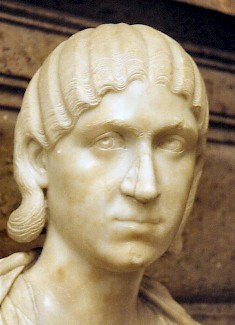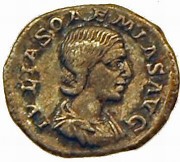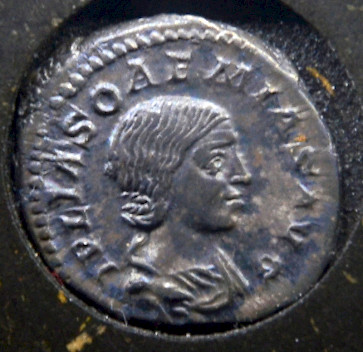Julia Soeamias
Julia Soaemias (c.180-222): empress of the Roman empire, mother of Heliogabalus (emperor 218-222).

Julia Soaemias was born in Apamea in Syria as the first daughter of Gaius Julius Avitus Alexianus and Julia Maesa; she was the elder sister of Julia Mamaea. In c.193, she married to another Apamean, Sextus Varius Marcellus, a Roman knight with a distinguished career; this marriage may have been part of a larger political game, because in that year, Soaemias' uncle Septimius Severus had unexpectedly become emperor, and was fighting with Pescennius Niger for the throne, and the latter was based in Syria. Soaemias' marriage to a Syrian may have strengthened Severus' position in the east.
After Severus' coming to power, Soaemias belonged to the royal dynasty, and she is known to have been present during the saecular festival of 204, which was celebrated every 110 years. At about the same time, she and her husband celebrated the birth of a son named Varius Avitus Bassianus, who was born in 203 or 204.
Soaemias may have visited Britain where Severus launched a military campaign against the Caledonians in 208. Her husband served as procurator in this outlying province. After the death of Severus and the accession of Caracalla, he was briefly a rationibus (head of the imperial finances), acted as praetorian prefect and city prefect, and became governor of Numidia, where he died before Caracalla was assassinated in 217.

Caracalla was succeeded by Macrinus, but Soaemias' mother Julia Maesa wanted to regain the throne that belonged to her family. The story was told that Julia Soaemias had once had a brief affair with Caracalla, and that Varius Avitus Bassianus was in fact the former emperor's son. (This stratagem had been proposed by a man who is variously called Gannys and Eutychianus; he is called Soaemias' lover, which may be true and may be gossip.) Maesa proceeded to bribe the Third legion Gallica, which now supported the claim of Soaemias' son, who had already made himself popular as priest of the sun god Elagabal in Emesa. Macrinus was defeated and executed, and the family returned to Rome. The boy became known as Heliogabalus.

Among the first victims of the new regime was Gannys/Eutychianus, who had been Heliogabalus' king-maker. It was ungrateful, but it made sense. A Roman ruler was not supposed to owe the throne to someone else.
Like her mother, Soaemias received the title of augusta, and coins were minted with her portrait. Still, we must not exaggerate her influence on Roman politics. After the winter of 220/221, Heliogabalus launched his revolutionary religious policy: the god Elagabal and his two consorts, Atargatis and Astarte, were to become more important than the old gods of the Roman state. Not everyone appreciated the emperor's passion for the Emesene sun god, however, and his marriage to a Vestal Virgin, Aquilia Severa, caused a major scandal. It seems that Soaemias was unable to restrain the boy-emperor.

In the summer of 221, Heliogabalus appears to have moderated his religious policy. The temple of Elagabal had been inaugurated, his festival had been celebrated; there was some room for concessions to those who felt offended. Soaemias and Julia Maesa convinced him to accept his cousin Alexianus, the son of Julia Mamaea, as caesar; after the adoption, the caesar was called Severus Alexander. Heliogabalus also divorced from the Vestal Virgin, and married to a Roman lady, a descendant of the beloved former emperor Marcus Aurelius.

However, this moderation was only temporary: in December 221, Heliogabalus remarried Aquilia Severa and tried to get rid of Severus Alexander. In this conflict, Julia Maesa and the Senate backed the caesar, and on 11 or 12 March 222, Heliogabalus and Soaemias were lynched by the soldiers. Both suffered damnatio memoriae.